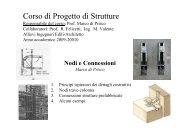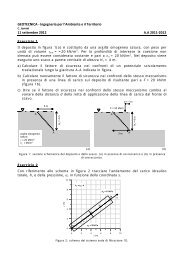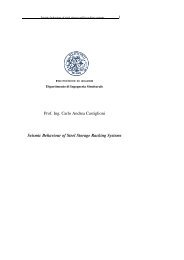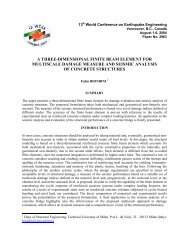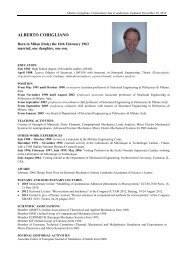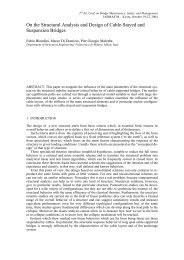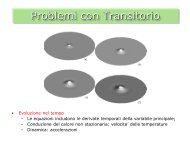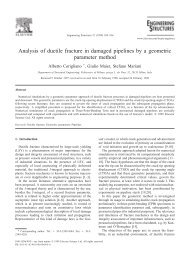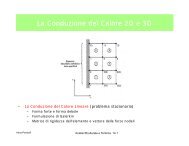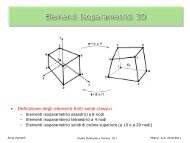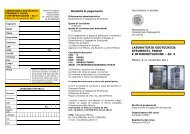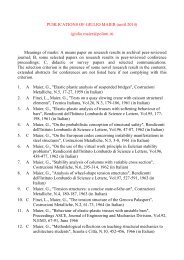Tesi Specializzazion.. - Ingegneria Strutturale - Politecnico di Milano
Tesi Specializzazion.. - Ingegneria Strutturale - Politecnico di Milano
Tesi Specializzazion.. - Ingegneria Strutturale - Politecnico di Milano
You also want an ePaper? Increase the reach of your titles
YUMPU automatically turns print PDFs into web optimized ePapers that Google loves.
Formulazione dell’elemento finito tri<strong>di</strong>mensionale Cap. 2<br />
Sviluppando le parentesi è possibile identificare due termini, il primo è una una matrice <strong>di</strong> rigidezza<br />
33x33, che rappresenta l’aumento <strong>di</strong> rigidezza dell’elemento finito dovuto alla barra embedded:<br />
K<br />
b<br />
T T<br />
( N − N ) ⋅T<br />
⋅T<br />
⋅ ( N − N )<br />
A ⋅ Ec<br />
= ⋅<br />
(2.45)<br />
A B<br />
A B<br />
L<br />
da notare che il prodotto delle due matrici T risulta pari alla matrice (2.36) utilizzata per i vincoli<br />
elastici:<br />
~<br />
T = T<br />
T<br />
⋅T<br />
2<br />
⎡ cos ( θ<br />
x<br />
)<br />
⎢<br />
= ⎢cos(<br />
θ<br />
y<br />
)cos( θ<br />
x<br />
)<br />
⎢<br />
⎣<br />
cos( θ<br />
z<br />
)cos( θ<br />
x<br />
)<br />
cos( θ )cos( θ )<br />
x<br />
2<br />
cos ( θ )<br />
cos( θ )cos( θ )<br />
z<br />
y<br />
y<br />
y<br />
cos( θ ⎤<br />
x<br />
)cos( θ<br />
z<br />
)<br />
⎥<br />
cos( θ<br />
y<br />
)cos( θ<br />
z<br />
) ⎥<br />
2<br />
cos ( θ ) ⎥<br />
z ⎦<br />
(2.46)<br />
Il secondo termine che deriva dalla (2.44) è il vettore delle forze nodali equivalenti alla<br />
precompressione:<br />
F<br />
p<br />
c<br />
T T<br />
( N − N ) ⋅T<br />
⋅ε<br />
bi<br />
= A⋅<br />
E ⋅<br />
(2.47)<br />
A<br />
B<br />
T T<br />
T T<br />
Si nota che i prodotti matriciali ( N − N ) ⋅T<br />
⋅T<br />
⋅ ( N − N ) e ( N N ) ⋅T<br />
⋅ε<br />
bi<br />
A<br />
B<br />
A<br />
B<br />
A<br />
− forniscono<br />
delle costanti, perciò non è necessaria la loro valutazione ad ogni passo <strong>di</strong> carico in caso <strong>di</strong><br />
comportamento non lineare del materiale.<br />
La <strong>di</strong>fficoltà è ora nel valutare le matrici delle funzioni <strong>di</strong> forma nei punti A e B, in coor<strong>di</strong>nate<br />
naturali. I punti A e B sono noti infatti in coor<strong>di</strong>nate cartesiane, e la trasformazione che porta le<br />
coor<strong>di</strong>nate nel sistema naturale è nota solamente se l’esaedro non è <strong>di</strong>storto:<br />
B<br />
ξ = ( x − xc ) / a η = ( y − yc ) / b ρ = ( z − zc ) / c<br />
(2.48)<br />
dove il punto c è il baricentro dell’elemento, ed a, b, c sono i suoi semilati. In caso contrario è<br />
necessario il calcolo delle coor<strong>di</strong>nate nel sistema naturale tramite iterazione.<br />
38




